Interim Report FY17
Interim Report FY20
Interim Report FY21
Interim Report FY22
Interim Report FY23
Using genetics to determine the breeding areas of Common Eiders harvested in the Atlantic Flyway

Project Number: 150
Year Funded: 2016
Lead Institution(s): US Geological Survey
Project Lead: Sarah Sonsthagen
Collaborator(s): Chris Dwyer (USGS), Scott Gilliland (CWS)
Location: Atlantic Flyway
Focal Species: Common Eider (Somateria mollissima)
Project Description: An assessment of the harvest potential of American common eiders suggested that under current harvest policies and given our understanding of demographic information throughout the range of this species, there is a substantial risk of overharvest. Furthermore, American common eiders may be experiencing different demographic rates throughout their breeding range (i.e., declining abundance in Maine & Maritime Canada, stable to increasing in the St. Lawrence estuary, and an increasing population in along the Northshore of the Gulf of St. Lawrence & in Newfoundland and southern Labrador). Determining the geographic source(s) of common eiders in the U.S. and Canadian harvest may help reduce uncertainty in harvest management decision-making, develop priority areas for habitat conservation efforts and identify potential differences in relative productivity across the breeding range of American common eiders. We are applying a genetic approach to probabilistically assign common eiders harvested along the Atlantic Flyway to natal areas. Genetic information from 12 microsatellite loci, mtDNA control region, and 9 restriction site associated DNA loci have been collected from breeding reference locations and hunter-harvested eiders during the 2013/14 to 2019/20 seasons in the Atlantic Flyway.
Project Reports:
